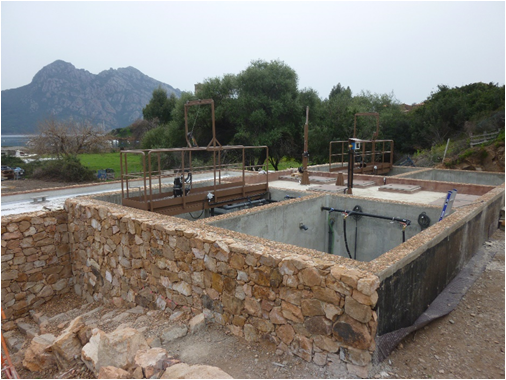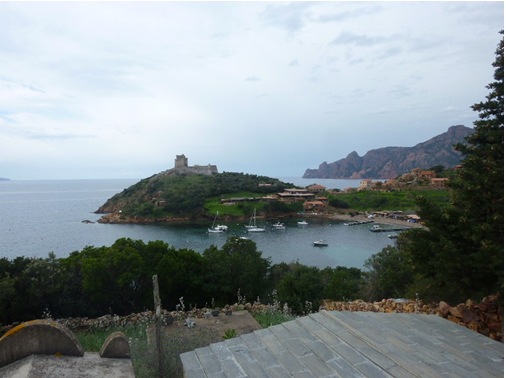Wastewater Treatment Plant at Girolata – A Corsican Challenge
As regards the technology, the process equipment had to face a wastewater source with a strongly fluctuating inflow. Owing to the fact that the relevant area is mostly a recreational locality, a multistage treatment plant was designed based on the input data. The plant consists of a mechanical pre-treatment section with compaction of screenings with a by-pass at hand-operated trash screens, grease separator with an enzymatic-agent dosing device, aeration section and a wastewater pumping station transferring the water stream to a multistage biological section. For the winter season, an SBR reactor has been designed for a minimum capacity of 20 inhabitants, while for the summer months, a continuous double section with denitrification and nitrification stages plus secondary settling tanks was designed, where the original SBR (winter) was purported as a mixing tank and anaerobic reactor in case of elevated water levels. An integral part of the biological section is a sludge tank used for interim storage of excessive sludge and, partially, for inoculation of the biological section before the main season and, in the first place, for the sludge storage after the season, before its gradual de-watering on the vegetation filter. Further treatment steps consist in the wastewater disinfection in the UV (ultraviolet radiation) radiation unit. After flowing through the Venturi measurement trough, the water is soaked-in through the AS-KRECHT accumulation tunnels and over sand bedding discharged to the brackish water; the wastewater treatment plant is situated at a coastal strip.

As regards the technology, the process equipment had to face a wastewater source with a strongly fluctuating inflow. Owing to the fact that the relevant area is mostly a recreational locality, a multistage treatment plant was designed based on the input data. The plant consists of a mechanical pre-treatment section with compaction of screenings with a by-pass at hand-operated trash screens, grease separator with an enzymatic-agent dosing device, aeration section and a wastewater pumping station transferring the water stream to a multistage biological section. For the winter season, an SBR reactor has been designed for a minimum capacity of 20 inhabitants, while for the summer months, a continuous double section with denitrification and nitrification stages plus secondary settling tanks was designed, where the original SBR (winter) was purported as a mixing tank and anaerobic reactor in case of elevated water levels. An integral part of the biological section is a sludge tank used for interim storage of excessive sludge and, partially, for inoculation of the biological section before the main season and, in the first place, for the sludge storage after the season, before its gradual de-watering on the vegetation filter. Further treatment steps consist in the wastewater disinfection in the UV (ultraviolet radiation) radiation unit. After flowing through the Venturi measurement trough, the water is soaked-in through the AS-KRECHT accumulation tunnels and over sand bedding discharged to the brackish water; the wastewater treatment plant is situated at a coastal strip.
As regards the logistic-transportation issues, the locality is rather difficult, because the construction site – even though being in Europe and Corsica – is not accessible by a road. So that all components necessary for the construction and process equipment fixing had to be transported by lorries first, then by shipping, then again by road to the reloading place and from there repacked for a helicopter transport in individual pieces (each up to 300 kg) to the construction site. In addition, the transport of tools, instruments, and fitters had to be made in a like manner – only with the exception of the last lap, which was made by a ship and not a helicopter.
In the terms of architecture, the construction should have belonged to the local landscape so that even tourists viewing it from the adjacent two-thousand-metre hilltops could not tell its practically industrial character. In this point, architectural requirements were often contradictory to process functions and consequent “operationability” of the equipment. As a result, the entire concrete building is lined with stone cladding and even its tank heads are lined with small pebbles. In addition, all stainless steel structures, including footbridges, small cranes, and composite covers were painted in the approved colour shade corresponding to the colour of the local rock massif.
The construction of concrete structures alone was very complicated due to the site inaccessibility. Transporting of prepared concrete mixtures was out of question and therefore all items, with the exception of cement, had to be used from local sources. Several aggregate sizes for concrete mixtures were identified in the local riverbed and necessary machinery and equipment for concrete production and handling were brought to the site on pontoons. Naturally, these complications adequately extended the construction period.
Many organisations and other aspects, often with contradictory requirements and interests, interfered with the project both in the planning and preparation period, as well as in the period of delivery of individual construction parts and process equipment and/or in the erection schedule, which unsurprisingly complicated smooth project works. In particular, some architectural requirements were completely at variance with the utilisation purpose and operating ability of the plant as well as with the occupational safety and health codes.

Taking into account all such aspects, our installation of process and electrical equipment advanced without any significant problems and – as compared to the quality of local works – on a very professional level. Within twelve days, we carried out the complete installation of our process equipment, including electrical wiring among individual pieces of machinery and equipment. This resulted in a very nice wastewater treatment plant in a magnificent environment of Corsica, at the seaside and within the scenery of hilltops that were, in the time of our work, still snow-covered.
Ing. Antonín Vondruška
Next articles
ASIO CELEBRATES ITS 30TH ANNIVERSARY … a reason for retrospection and de-liberation as how to proceed in the future
In the turbulent waters of the nineties, a company emerged on the market that was founded as a grass root development.
Learn more …
13. 6. 2023
Polypropylene Pickling Tanks
It is a robust plastic structure, which is evidenced by the fact that the tank contains a solution of 20% acid at temperatures reaching even the level of 80 0C.
Learn more …
30. 4. 2023